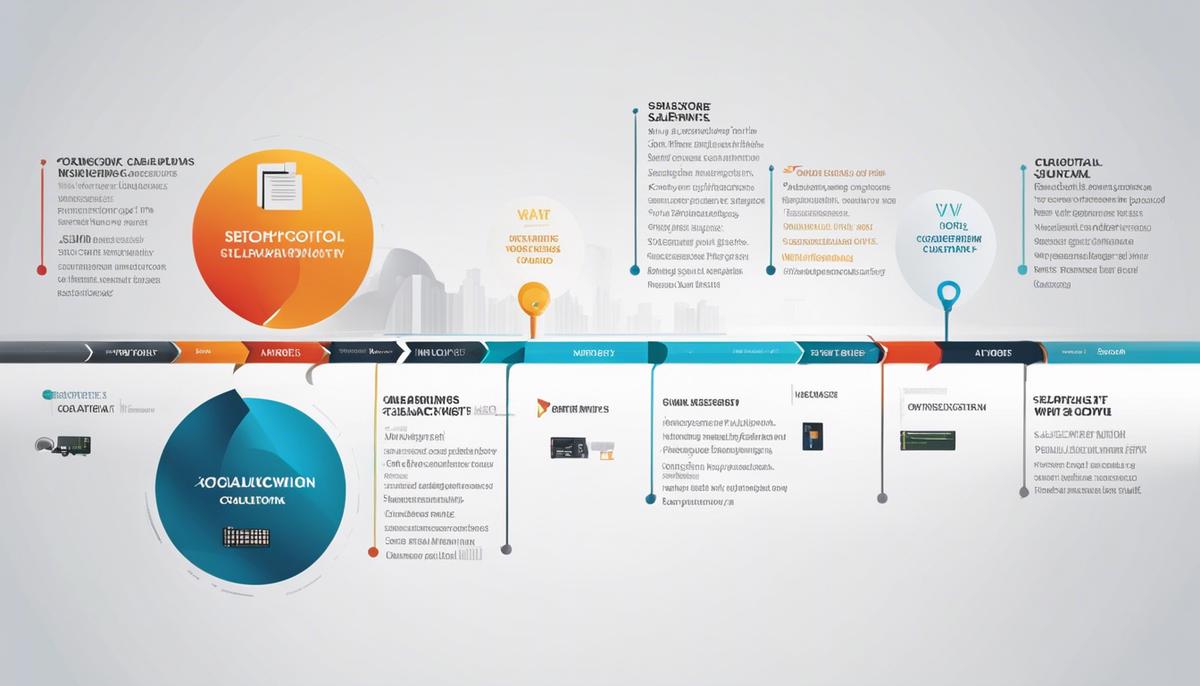In today’s fast-paced digital landscape, the way we collaborate on writing has undergone a remarkable evolution. Tools that facilitate teamwork are no longer considered a luxury but a necessity for writers seeking to bridge the constraints of time and space. This essay unfolds the tapestry of digital collaboration tools, tracing their journey from the simplicity of yesteryears’ face-to-face interactions and cumbersome track changes to the sophisticated platforms we’ve come to rely on. These platforms aren’t just reshaping our methods of communication; they’re reinventing them—enabling real-time editing, meticulous version control, and the luxury of asynchronous discussions that continue to redefine the art of collaborative writing.
The Evolution of Collaboration Tools
How Collaboration Tools Are Changing the Game for Team Writing
In today’s fast-paced business environment, effective team collaboration is the bedrock of innovation and success. The digital age has brought with it a revolution in the way we work, especially in the realm of team writing. Thanks to cutting-edge collaboration tools, gone are the days of disjointed email threads, confusing version control, and the cumbersome back-and-forth of document sharing.
Imagine the productivity unleashed when teams can work on the same document simultaneously, no matter where they are in the world. Real-time editing, instant messaging integration, and trackable changes have transformed the way writing projects are managed. These tools allow each team member to bring their unique expertise to the table, integrating their contributions seamlessly.
Collaboration platforms such as Google Docs, Microsoft Office 365, and Slack, to name a few, have democratized content creation by making it more accessible and inclusive. These tools break down silos, ensuring the collective intelligence of a team is harnessed effectively. The result? Streamlined processes, increased transparency, and accelerated decision-making.
Moreover, the insights gained from collaborative contributions provide invaluable data that can be leveraged to optimize team workflows, making the process more efficient with every project. The ability to comment directly on work, provide feedback instantaneously, and implement revisions in real time shortens the development cycle of documents and writing projects. It allows teams to pivot quickly, stay agile, and maintain a competitive edge.
For the visionary entrepreneur, these collaboration tools are not just about increasing efficiency; they’re about fostering a culture of synergy and innovation. They eliminate the friction of conventional writing processes, allowing creativity and strategic thinking to flourish. With these technologies, it’s clearer than ever that the collective efforts of a well-synchronized team are far greater than the sum of its parts.
In the ever-evolving landscape of business, embracing these collaborative writing tools isn’t just recommended, it’s imperative. As we continue to charge through the 21st century, the fusion of technological prowess and collaborative spirit will remain a hallmark of forward-thinking enterprises. The revolution in team writing is here, and it’s changing the face of business communication as we know it.

Essential Features of Collaboration Software
In today’s fast-paced business arena, seamless coordination among writing team members is a game-changer. Collaboration tools are not just a convenience; they are a bedrock of competitive strategy. Pinpointing their indispensability, one must recognize the nuanced needs of writing teams – needs that transcend basic communication.
Consider the tight deadlines and the pressure to produce high-caliber content. Collaboration tools are the Swiss Army knives in these scenarios, enabling writers to co-author documents simultaneously. This functionality is the muse that turns the chaos of multiple edits into a symphony of coherent final drafts.
Diving deeper, consider the diversity in a team’s tech savviness. Collaboration platforms, with their intuitive interfaces, level the playing field, bringing every member up to speed without cumbersome learning curves. That’s more than a feature; it is a lifeline for maintaining momentum and ensuring everyone contributes their expertise with minimal friction.
Now, envision the lifecycle of a document. How does one ensure that the process from draft to publication is not only smooth but also maintains integrity and accountability? Enter version history features offered by contemporary collaboration tools. They track changes with surgical precision, resolving any ambiguity around contributions and revisions. This is not just convenient; it is a bulwark against miscommunication and potential conflicts.
One must not overlook the role collaboration tools play in project management. With built-in task management features, they serve as central hubs for assigning responsibilities, setting deadlines, and monitoring progress. For a writing team, this converts a multitude of potential emails and follow-ups into a single, clear dashboard of action items. This organizational prowess is not a perk; it is the scaffolding that upholds project timelines and quality standards.
Lastl,y consider the strategic edge these tools provide. With their ability to integrate seamlessly with data analytics and SEO tools, writing teams can craft content that isn’t just good – it’s targeted and optimally impactful in the ever-evolving algorithms of digital space. This alignment with marketing effectiveness is not optional; it is quintessential for content to thrive in the digital ecosystem.
In essence, collaboration tools have transcended being mere gadgets in a writer’s toolkit. They have become the arteries of idea exchange, the cradle for nurturing concepts, and the engines propelling content to greatness. When viewing the tapestry of needs within a writing team, it’s unequivocally clear: collaboration tools are the critical backbone of creative excellence and operational acumen.

Choosing the Right Tool
Selecting the Ultimate Team Collaboration Arsenal: Beyond the Buzzwords
In the fast-paced marketplace, the arsenal you arm your team with can make or break operational success. The digital terrain is brimming with collaboration tools promising to streamline your processes, but savvy leaders know that not all tools are cut from the same cloth. So, how do you gear up with the best without getting lost in the tech jungle?
Identifying specific team needs is your first call to action. Are the team members all in one place, or scattered across the globe? Do your projects require heavy resource-sharing or frequent, rapid communication? Pinpoint the unique quirks of your workflow.
Next, size matters – the size of your team and your projects. Tools that work like a charm for a small squad may buckle under the weight of larger groups or more complex tasks. Test the scalability; robust tools grow with your business.
User-friendliness takes center stage when your team spans the gamut from tech whizzes to those less digitally adept. A tool with a steep learning curve numbs enthusiasm and hampers productivity. Go for intuitive interfaces that require minimal training.
Let’s talk integrations – a collaboration tool that can’t shake hands with your existing software is like a lone wolf in a pack-driven world. Seek out tools offering seamless integration with your current systems to maintain cohesion and reduce redundancy.
Security is non-negotiable. Your ideas are your currency in the market; protect them with tools that have strong encryption, user authentication, and secure data storage. Nothing undermines team morale faster than a security breach.
And while on the topic of morale, ensure your choice promotes engagement. Tools with features that encourage participation and recognition foster a harmonious and motivated team environment. Healthy team dynamics fuel innovation.
Your tool of choice should be mobile-friendly. We live in a world on-the-go; your team shouldn’t feel chained to their desks. Mobile access ensures that inspiration and essential communication flow uninterrupted, anywhere, anytime.
Cost-effectiveness is also key – evaluate the return on investment of any tool. A pricy option with bells and whistles is futile if it doesn’t deliver value proportional to your investment. On the other hand, free doesn’t always equate to optimal. Balance features with affordability.
Last ly, never underestimate the power of a trial run. Dive into free trials or demos; they are perfect for road-testing a tool’s potential fit within your team’s ecosystem. Only by putting tools through the trenches of your daily operations can you evaluate their true mettle.
Teams equipped with the right collaboration tool are powerhouses of productivity and creativity. Remember, in the symphony of business success, each team’s composition is unique; therefore, their instruments must be tailored to perfection. Select with wisdom, and watch team synergy soar to new heights.

Best Practices for Collaboration Tool Utilization
Maximizing Impact: Harness the Power of Advanced Features in Collaboration Tools
As businesses scale and market pressures escalate, refined utilization of collaboration tools becomes indispensable. Leaders must look beyond fundamentals and leverage advanced features to stay ahead. Here are the gold standards to get the most out of these platforms:
- Customization and Scalability: Adapt tools to fit the unique rhythms of your team. Custom templates, automated workflows, and scalable features that grow with your business are vital. This proactive approach means a tool should conform to the business and not the other way round.
- Integration with Larger Ecosystems: The best collaboration tools don’t operate in isolation but plug into a broader digital ecosystem. Think CRMs, ERP systems, and marketing automation platforms. Interoperability is key to streamlining processes and ensuring a frictionless transfer of information.
- Advanced Analytics and Reporting: To drive business growth, collaboration tools with robust analytics and reporting give a competitive edge. They help visualize progress, pinpoint inefficiencies, and make data-driven decisions that propel projects forward.
- Personalization for the User Experience: Tailoring user experiences to individual preferences increases adoption rates and productivity. Options like dark mode, notification settings, and layout choices empower users to work in their comfort zones, boosting morale and output.
- Real-Time Communication and Collaboration: Immediate synchronization across devices and platforms isn’t optional; it’s a requirement. Teams that communicate in real-time can make quick decisions, pivot as necessary, and maintain momentum.
- Artificial Intelligence and Machine Learning: Embedding AI into collaboration tools for predictive typing, intelligent search, and automated task prioritization isn’t futuristic—it’s happening now. These features can reduce menial tasks, giving teams more time to focus on strategy and creation.
- Training and Support Systems: No tool is effective without proper training. Offering clear, concise learning modules and responsive support ensures that all team members can navigate and fully utilize the features of a tool without extensive downtime.
- Robust Access Controls and Audit Trails: Control over who can see and edit content, coupled with the ability to audit changes, provides security and accountability. This level of control is essential for maintaining the integrity and confidentiality of sensitive projects.
- Adaptive Learning Capabilities: Collaboration tools of today must learn and evolve based on usage patterns. They should recommend best practices, short-cuts, and features that align with the team’s behavior, leading to continuous improvement in team dynamics.
Seize these advanced capabilities of collaboration tools to unlock the full potential of your team. Each step into this territory of sophistication ensures a competitive advantage that can differentiate your services and products in a crowded marketplace. Don’t just collaborate; innovate and lead with the most advanced toolset at your disposal.

Photo by kaleidico on Unsplash
The transformative journey of writing collaboration tools brings us to a vantage point where the mastery of these platforms is as much an art as it is a technical skill. Embracing essential features, selecting the ideal tool, and adhering to best practices doesn’t just enhance productivity; it allows writing teams to weave ideas into narratives with unprecedented precision and harmony. As we continue to navigate the vast seas of digital collaboration, let us steer with an understanding that the true power of these tools lies in their ability to connect minds and bring to life the collective genius of writers around the world.






